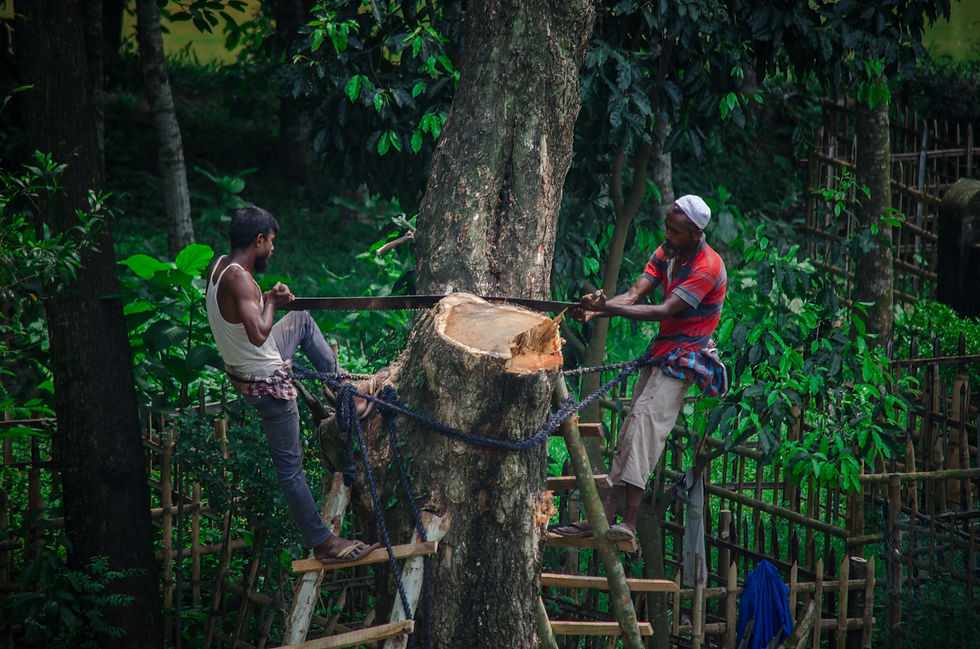Ancient History Of West Bengal
- Shreya Giri
- Jan 1, 2024
- 7 min read
Explore the rich tapestry of West Bengal's ancient history, a captivating journey through the epochs that shaped this culturally vibrant region. Unearth the treasures of ancient civilizations, from the vibrant terracotta temples of Bishnupur to the scholarly centers of Nalanda. Embark on a virtual expedition to West Bengal's ancient history, revealing the hidden gems that make this land a testament to the grandeur of yesteryears.

West Bengal is one of India's major states, located in Eastern India. Bengal's history encompasses the entire state of Bengal, including both West Bengal and East Bengal (now Bangladesh). Bengal is mentioned for the first time in the Mahabharata. Its territory has been governed by various dynasties.
Bengal's history dates back to the time of the Aryan conquest of India. In ancient Sanskrit literature, Bengal is known as Gauda or Vanga. Some of the material discovered in West Bengal offers information about the habitation and prehistoric stone artefacts. The ancient Greeks and Romans called the region of Bengal Gangaridai. Some experts claim that the term "Banga" is derived from the "Bong tribe."
Origin of People in West Bengal
The Bengalees are an Indo-Aryan ethnic group that mostly inhabits Bangladesh as well as the Indian states of West Bengal, Tripura, Assam, and Jharkhand. They are not Aryans' descendants. Kola, Sabara, Pulinda, Hadi, Dom, and Chandala were some of the early settlers in this area.
According to anthropological and archaeological evidence, Bengali-speaking people are comprised of many racial elements with diverse ethnic origins. The Bengalee race was formed by the confluence of three key racial groups. The Dravidians, Mangolian tribes, and Aryans were among them.
Some researchers also believe that people in Bengal are descended from Homo-alpinus, who lived in the Pamir and Taklamakan regions. Sir Herbert Risley conducted the first scientific research into the origins of the Indian people. He was the first to establish a link between Bengali people's round heads and Mongoloid traits.
He saw these people as common descendants of Dravidians and Mongoloids. RP Chanda, who argued in behalf of the Bengaler, strongly disagreed. His virginating from the Homo-alpinus that came from the Pamir region and spoke in an Indo-European language.

Pre-historic Period
West Bengal's pre-history covers the Palaeolithic, Mesolithic, Neolithic, and Chalcolithic periods. These are described more below:
Palaeolithic Period
This state has 162 lower Palaeolithic sites. The majority of the lower Palaeolithic sites have been documented from the Radh plain, and they are found on the foothills, valley slopes, and river banks. The tools in this location were mostly constructed from quartz and quartzite pebbles. Egara Mail (Burdwan), Parihati, Mohanpur, Satbati, Tarapheni reservoir bridge (all in Midnapore), Nakbindhi, Patina, Jibdharipur (Birbhum), Jagannathpuri, and others are noteworthy places.
West Bengal has documented 41 Middle-Palaeolithic period sites located in the districts of Bankura, Midnapore, Birbhum, and Burdwan. This region's middle Palaeoliths are distinguished by the presence of flake tools. In West Bengal, a total of ten Upper Palaeolithic sites have been discovered. These are in the districts of Midnapore, Bankura, and Burdwan. Upper Palaeolithic tools from West Bengal are distinguished by backed blades, spear heads, and other features, and were fashioned from green quartzite, chert, quartz, sandstone, and other materials.
Mesolithic Period
Only three sites have been excavated: Birbhanpur in Burdwan district, Paruldanga in Birbhum district, and Chamargora in Midnapore district. This region's Mesolithic sites produced lithic (stone-related) collections of both non-geometric and geometric varieties. Spears, scrapers, agricultural implements, and other artefacts were created of quartz, quartzite, fossil wood, and other materials.
Neolithic Period
In West Bengal, 84 Neolithic sites have been discovered. The nature and location of Neolithic evidence in West Bengal reveal two Neolithic cultural foci with opposing development trajectories. They are the Himalayan foothills, which include Kalimpong and the neighbouring Sikkim state, and the plateau fringe area, which includes the districts of Midnapore, Bankura, Purulia, Burdwan, and Birbhum.
The Neolithic culture of the plateau area is distinguished by Neolithic tools with distinguishing grey and pale ceramics, whereas the Neolithic culture of the Himalayan foothills is distinguished by Neolithic implements devoid of pottery.

Chalcolithic Period
BB Lal and Pandu Rajar Dhibi discovered the first Chalcolithic or Copper Age site on the bank of the Ajay river in West Bengal's East Bardhaman district in 1954-57. It dates from 1600 BC. These findings demonstrated that the people of West Bengal understood the significance of town planning and its formulation. They constructed well-planned towns. The roadways were built of stones, gravels, and clay mixed with water. Small channels connected the streets and drained the water to a common place.
Copper was utilised by prehistoric people to make hand tools and implements for agriculture and hunting. Agriculture and trade were the backbones of their economy. They raised rice and other seasonal crops. Aside from that, they domesticated domestic animals for cattle and milk. Prehistoric sites have been discovered in the south-western region of West Bengal.
Ancient Kingdoms/Dynasties of West Bengal
There were various ancient kingdoms/dynasties in West Bengal. Some of these are discussed below:
Vanga Kingdom
The Vanga kingdom was an ancient empire on the Indian subcontinent during the Post-Vedic period that started in the Bengal region. It was mentioned in the epic Mababbarata. Its modern neighbours were Suhma, Anga, Pundravardhana, Samatata, and Harikela. According to the Mahabharata, the Vanga army was proficient in handling war elephants and sided with the Kauravas.
The Vanga kingdom was surrounded on the west, north, and east by the Padma and Bhagirathi rivers, and on the south by the Bay of Bengal. Angas, Vangas, Kalingas, Pundras, and Suhmas all had common ancestors. They were all the adoptive sons of a monarch named Vali or Bali, who was the son of a sage named Gautama Dirghatamas. There is a little bit of information about Vanga.
Anga Kingdom
Anga was an early kingdom that ruled over parts of Bengal and modern-day central Bihar. Champa (previously Malini) was its capital. All Anga kings descended from King Bali. Duryodhana made his friend Karna King of Anga, according to the Mahabharata. According to the Ramayana, Lord Shiva burned Kamadeva, the deity of love, to death at Anga.
Pundra Kingdom
It was a West Bengal-based Eastern kingdom. This group of people was commanded by King Pundravardhana, who ruled from North Bengal to the country that is now Bangladesh. Pundra, also known as Bharata Varsha or India, belonged to the martial Kshatriya tribes. The Pundra dynasty did not adhere to Vedic culture at the time. Paundraka Vasudeva was a renowned Pundra dynasty leader. He joined the three districts of Pundra, Vanga, and Kirata and formed an alliance with Jarasandha of Magadha.
Suhmas Kingdom
The first mention of the Suhmas and their homeland appears in the Jaina Acharanga Sutra from the sixth century BCE. Many conventional and legendary traditions about the Suhmas' origins are preserved in early sources. According to the Mahabharata, the Sutras were created by Subma, Bali's son. Suhmas occupied a wide territory that comprised sections of the contemporary districts of Burdwin, Hooghly, Midnapore, Nadia, portionds, landhidabad, and 24-Parganas, i.e. Hooghing up to the sea. In other words, the region west of the Bhagian extending into the sea fell under the territorial jurisdiction of the Suhma Kingdom, where the Suhmas lived.

Harikela Kingdom
Harikela was an ancient Bengali monarchy that ruled over much of the Indian subcontinent's eastern areas. The kingdom is mentioned in several historical documents as well as archaeological items like as silver coins.
In the early time, Arab traders regarded Harikela (known as Harkand in Arabic) as the coastal regions of Bengal. Harikela monarchs were defeated by Chandra rulers in the 10th century CE.
Samatata Kingdom
Samatata was a prehistoric Indian area in South-East Bengal. The Allahabad Prashasti contains the earliest mention of it. The mountains of Tripura and Arakan in the east and the Meghna (the combined waters of the Padma, Meghna, and Brahmaputra rivers) in the west formed the boundaries of Samatata.
This kingdom is largely unknown. In the late seventh century, it was ruled by Buddhist kings. In their works, Chinese explorers such as Xuanzang and Yijing, as well as Roman geographer Ptolemy, mentioned this kingdom.
Nanda Dynasty
The Nanda dynasty arose in ancient India's Magadha region during the fourth century BCE and lasted from 345 to 321 BCE. The Nanda dynasty's kingdom stretched from Bengal in the east to the Punjab area in the west at its peak.
The emperors of this dynasty were famous for amassing vast amounts of riches. According to Jaina, Buddhist, and Puranic sources, there were nine Nanda Kings in total. This dynasty's most notable monarchs were Mahapadma Nanda and Dhana Nanda.
Mauryan Dynasty
It was founded in 322 BCE by Chandragupta Maurya, who established his dominion around Magadha. The Mauryan empire was one of the largest empires in the world at the time, and the largest ever in the Indian subcontinent, including Bengal. Emperors Chandragupta and Bindusara expanded the empire into India's central and southern areas. The Mauryan empire ruled over the entire region of Bengal. Following the Kalinga War, the empire enjoyed nearly a half-century of peace and tranquilly under Ashoka.
Gupta Dynasty
The Gupta Dynasty (320–550 CE) was an ancient Indian kingdom created by Srigupta that ruled over a large portion of the Indian subcontinent, including Bengal. According to the writings of Buddhist Monk Yijing circa 690 CE, a section of Northern or Central Bengal was the residence of the Guptas at the time. The Gupta dynasty was founded by Maharaja Srigupta, according to the Poona copper inscription of Prabhavati Gupta, Chandragupta's daughter.
Ghatotkacha was the son of Maharaja Srigupta, the founder of the Gupta dynasty, and a pre-imperial Gupta King in Northern India. He reigned from 280 to 319 E.
Around 320 CE, Chandragupta I was an important monarch of the Gupta empire. He is recognised for making connections with several powerful families in the Ganges region as the ruler of the Gupta empire.
Samudragupta was the Gupta empire's king and the heir of Chandragupta I. His kingdom encompassed all of Bengal and Assam. He was the third monarch of the Gupta dynasty, which ushered in India's Golden Age. He was possibly the greatest Gupta dynasty king.
Chandragupta II, commonly known as Vikramaditya, was one of the most powerful monarchs of India's Gupta kingdom. His reign lasted from 380 to 415 CE, during which time the Gupta empire reached its zenith.

About the Author
Shreya Giri is a talented SEO content writer with a unique flair for captivating readers. With a bachelor's degree in geography, her passion for crafting exceptional content shines through in every word she writes. Shreya's expertise lies in her ability to seamlessly blend language and storytelling, effortlessly capturing the attention of her audience.
She is currently pursuing a Master's degree in geography and has a remarkable talent for transforming intricate concepts into captivating narratives that have a lasting impact. With Shreya, you can expect excellent, captivating content that will keep you engaged from beginning to end.
You can connect with her through-
My-Lekh profile- lekh.com/profile/shreyagiri06/profile LinkedIn profile- https://www.linkedin.com/in/shreya-giri-a0a607265
Email- shreyagiri06@gmail.com





Comments